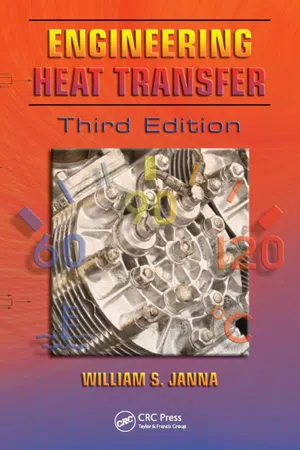
- 692 pages
- English
- ePUB (mobile friendly)
- Available on iOS & Android
Engineering Heat Transfer
About this book
Most heat transfer texts include the same material: conduction, convection, and radiation. How the material is presented, how well the author writes the explanatory and descriptive material, and the number and quality of practice problems is what makes the difference. Even more important, however, is how students receive the text. Engineering Heat Transfer, Third Edition provides a solid foundation in the principles of heat transfer, while strongly emphasizing practical applications and keeping mathematics to a minimum.
New in the Third Edition:
- Coverage of the emerging areas of microscale, nanoscale, and biomedical heat transfer
- Simplification of derivations of Navier Stokes in fluid mechanics
- Moved boundary flow layer problems to the flow past immersed bodies chapter
- Revised and additional problems, revised and new examples
- PDF files of the Solutions Manual available on a chapter-by-chapter basis
The text covers practical applications in a way that de-emphasizes mathematical techniques, but preserves physical interpretation of heat transfer fundamentals and modeling of heat transfer phenomena. For example, in the analysis of fins, actual finned cylinders were cut apart, fin dimensions were measures, and presented for analysis in example problems and in practice problems. The chapter introducing convection heat transfer describes and presents the traditional coffee pot problem practice problems. The chapter on convection heat transfer in a closed conduit gives equations to model the flow inside an internally finned duct. The end-of-chapter problems proceed from short and simple confidence builders to difficult and lengthy problems that exercise hard core problems solving ability.
Now in its third edition, this text continues to fulfill the author's original goal: to write a readable, user-friendly text that provides practical examples without overwhelming the student. Using drawings, sketches, and graphs, this textbook does just that.
PDF files of the Solutions Manual are available upon qualifying course adoptions.
Frequently asked questions
- Essential is ideal for learners and professionals who enjoy exploring a wide range of subjects. Access the Essential Library with 800,000+ trusted titles and best-sellers across business, personal growth, and the humanities. Includes unlimited reading time and Standard Read Aloud voice.
- Complete: Perfect for advanced learners and researchers needing full, unrestricted access. Unlock 1.4M+ books across hundreds of subjects, including academic and specialized titles. The Complete Plan also includes advanced features like Premium Read Aloud and Research Assistant.
Please note we cannot support devices running on iOS 13 and Android 7 or earlier. Learn more about using the app.
Information
Table of contents
- Cover
- Half Title
- Title Page
- Copyright Page
- Dedication
- Table of Contents
- Preface
- Acknowledgments
- Author
- 1 Fundamental Concepts
- 2 Steady-State Conduction in One Dimension
- 3 Steady-State Conduction in Multiple Dimensions
- 4 Unsteady-State Heat Conduction
- 5 Introduction to Convection
- 6 Convection Heat Transfer in a Closed Conduit
- 7 Convection Heat Transfer in Flows Past Immersed Bodies
- 8 Natural-Convection Systems
- 9 Heat Exchangers
- 10 Condensation and Vaporization Heat Transfer
- 11 Introduction to Radiation Heat Transfer
- 12 Radiation Heat Transfer between Surfaces
- Bibliography and Selected References
- Appendixes
- Index